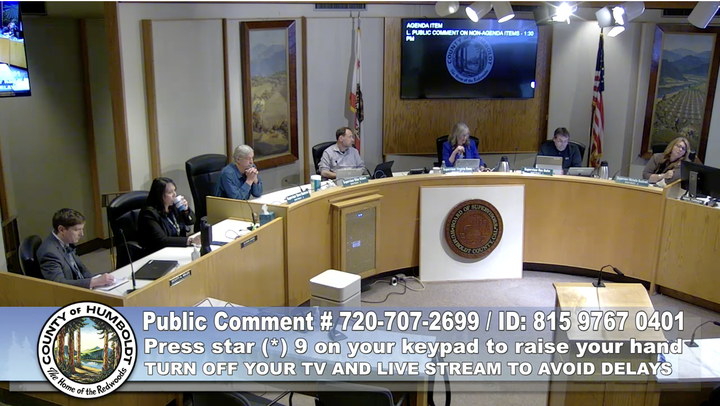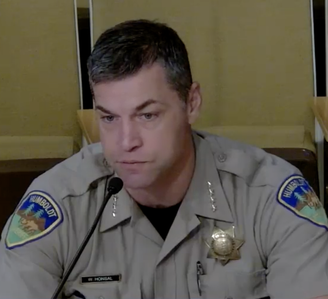Screenshot from Tuesday’s meeting.
A proposed letter to San Francisco’s District Attorney sparked a lengthy conversation among the Board of Supervisors on Tuesday — one that, on the surface, was about how best to address the influx of fentanyl and the ensuing spike in overdose deaths in Humboldt County.
Thanks to some pushback from a couple of supervisors — particularly Third District Supervisor Mike Wilson — the discussion wound up expanding to address a few broader criminal justice issues, such as the logic, tactics and unintended consequences of America’s ongoing War on Drugs.
First District Rex Bohn brought forward a draft letter to Chesa Boudin, San Francisco’s controversial, reform-minded DA whose efforts to reduce mass incarceration (among other matters) have drawn the ire of law enforcement groups, prosecutors and others who say he’s soft on crime and turning a blind eye to “open air dealing” in the city’s Tenderloin District. (Boudin is now facing a recall election.)
The draft letter urges Boudin to address the fentanyl crisis by “prosecuting all cases that are brought to your office,” and it threatens legal action against the City and County of San Francisco if Boudin and Humboldt County supes can’t find a “mutually acceptable solution shortly.”
Bohn characterized the letter as “a shot across the bow,” a warning to Boudin that he needs to step up and do his job. Humboldt County Sheriff Billy Honsal agreed, saying the letter would send the message that drug dealing is not a victimless crime, and that Humboldt County will not tolerate the continued influx of fentanyl from San Francisco.
Honsal said there have been nine confirmed deaths from fentanyl overdoses so far this year and nine others that his office believes were due to fentanyl. His department’s fentanyl arrest numbers have skyrocketed from two in 2019 to 40 so far this year, plus 22 from the county’s Drug Task Force.
Sgt. Matt Tomlin with the Drug Task Force addressed the supervisors, saying arrestees have given officers information that led them down to the city.
“What we’ve learned is how easy it is for Humboldt County people to go to the Tenderloin District and purchase fentanyl,” Tomlin said. “They’re buying ounces of fentanyl for $350 in the Tenderloin District and making back $100 a gram, so approximately $2,800, in Humboldt County.”
People have told officers that when they drive into the Tenderloin, “five or six people rush their car to try to be the first one to sell them the drugs,” he said. “It’s kept our team up 24 hours a day. We have to work when the drug dealers are working, and so we’re putting all of our time into this.”
Tomlin also talked about the burden of talking to parents in Hoopa and elsewhere who’ve lost young daughters to a fentanyl overdose.
“And until you have to look these people in the eye and talk to them about what you’re doing to try to solve that problem after they lost their children, you really [don’t] understand what the problem is,” he said. “And we need help with this problem.”
Honsal said he hopes other counties will follow Humboldt’s lead, “because a message has to be sent: Fentanyl is killing our people. And we would not allow anyone else to do this, so why are we allowing them to do it?”
When Wilson had a chance to weigh in, he started by acknowledging the seriousness of the issue and thanking the Drug Task Force for its work. But he voice concern about discussing a threat of litigation in open session, saying typically such matters are first addressed behind closed doors.
He also questioned how effective the letter would be in curtailing the county’s supply of fentanyl given the “whack-a-mole” dynamic of busting dealers. Hasn’t fentanyl also come to Humboldt County from Redding? he asked. “Why the focus on this versus everybody else?”
Honsal replied, “The fact is that virtually every one of our arrests is coming from the Tenderloin District in San Francisco.”
The sheriff acknowledged the whack-a-mole problem and offered a metaphor of his own, saying the supply of fentanyl is “just like a river. It goes through the path of least resistance, and right now that path goes through San Francisco. And when we shut down San Francisco, we will go to the next one.”
The fundamental inability of law enforcement alone to solve the problem “doesn’t deter us from having a drug task force,” Honsal said. “It doesn’t deter us from actually getting out there every day even though we know that we may just stop a little bit as opposed to the flood that’s coming in here.”
Busting the people they manage to bust “can matter to certain lives,” he continued. He commended Humboldt County District Attorney Maggie Fleming for holding drug dealers accountable, saying “they know they’re going to face consequences here.” Local law enforcement wants to send drug dealers a message: “We want them to try and go somewhere else,” Honsal said.
Wilson argued that the problem goes beyond San Francisco’s DA, noting that the police department there is short-staffed. He suggested sending the letter to other San Francisco officials, too, such as the sheriff, the mayor and the board of supervisors. And he suggested that it should offer coordination and assistance in addressing the issue.
Honsal held firm, saying the main problem is San Francisco’s open air drug market in the Tenderloin and the DA’s refusal to do anything about it.
Second District Supervisor Michelle Bushnell voiced support for the letter, saying to her the message is simple: “We have a problem in Humboldt County that we’re trying to deal with.” Noting the added danger of fentanyl getting laced into other substances, Bushnell said, “This is a serious letter because it’s a serious issue.”
Wilson again sought to go a little deeper. He remarked on the irony of officials in Humboldt County, of all places — long known as the epicenter of the world’s best marijuana — chastising other jurisdictions for exporting drugs, “legal or otherwise.” (Of course, it’s probably impossible to die from a cannabis overdose.)
Wilson also noted that enforcement can have unintended consequences: Pushing drugs further underground can make them more valuable, which, in turn, can lead to more violence. “We’ve seen that with cannabis in the past,” he said.
He also brought up social justice issues, noting the disproportionate impacts of the drug war on poor people and minorities. He brought up the use of the word “predator” in the draft letter, saying such terms can be “dog whistles for all kinds of racial injustice issues.”
Fifth District Supervisor Steve Madrone echoed those sentiments.
“I think we all recognize that these kinds of issues go far deeper than just the surface problem of the dealers in the Tenderloin,” he said. “It comes down to housing, it comes down to jobs, it comes down to more mental health services and so many other things that, you know, are lacking in many ways.”
Madrone said work needs to be done on long-term and short-term solutions.
Addressing Wilson’s “threat of litigation” concerns, Interim County Counsel Scott Miles suggested a minor tweak in the letter’s wording — changing a sentence toward the end to say the county may have to “consider” its legal options rather than “seek” one.
Bohn scoffed, saying he’d have to look those terms up in the dictionary to see what the difference is, but the changed proved to be enough to earn the letter support from the full board. With that minor alteration, they agreed unanimously to send the letter.


CLICK TO MANAGE